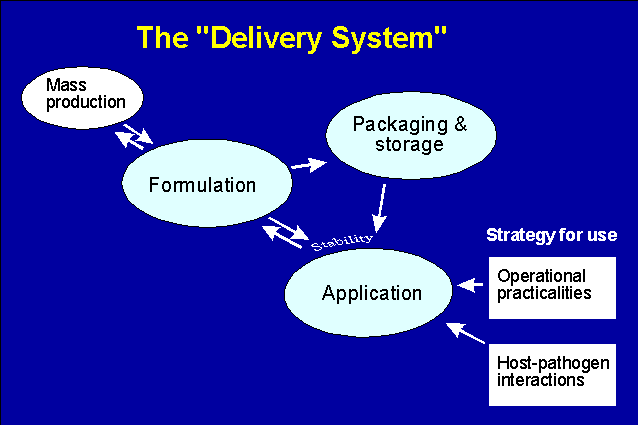
dropdata.net/biopesticides/biopesticide_delsys
updated: April 2007
| MycoHarvester | Biopesticide presentations |
Delivery Systems for Biopesticides
The development of appropriate delivery systems - is perhaps one of the most important technical concepts in the successful implementation of a biological (or indeed any other) pesticide. Research groups and smaller enterprises that develop biopesticides, may have an advantage in that this "joined-up thinking" is forced upon them by having relatively few (sometimes only 1-2) people responsible for production, formulation and application. Major agrochemical companies can afford to treat as separate departments (and nowadays application issues are often subsumed into product stewardship).

One of the most obvious features of biological agents is that they are necessarily particulate in nature (as opposed to being dissolved in the carrier liquid), yet the implication of this is frequently misunderstood or ignored. If the biopesticide is to be delivered as a spray the propagules must somehow must be suspended and distributed so that they have a reasonable chance of reaching the target site.
A major problem with current pesticide use is the poor standard of application to crops, and techniques used by commercial and semi-commercial developers of biological agents are no exception. Sloppy application of biopesticides may for instance be attributed to poor products (that demand the use of large orifice nozzles that emit poor quality sprays) and a belief that putative horizontal transmission mitigates the need for good delivery systems. In order to promote mycopesticide development, we here try to promote some of the "enabling technologies" that may facilitate transitions from the laboratory to field, to marketplace.
In the development of the ‘Green Muscle’ mycoinsecticide, it was important to establish not only that a range of standard application techniques were compatible with the product, but to ensure that the quality of the formulation maximised the distribution of the small amounts of spores (<100g) in very small quantities of carrier oil (<1 litre) over a hectare. Unlike particulate chemical products that can be milled, fungus spores are relatively delicate, so a device called the ‘MycoHarvester’ was designed to separate conidia safely and efficiently from the solid substrate normally used (e.g. grains such as rice).
